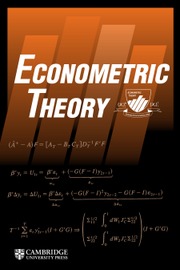No CrossRef data available.
Article contents
SUBVECTOR INFERENCE FOR VARYING COEFFICIENT MODELS WITH PARTIAL IDENTIFICATION
Published online by Cambridge University Press: 07 July 2025
Abstract
This article considers a general class of varying coefficient models defined by a set of moment equalities and/or inequalities, where unknown functional parameters are not necessarily point-identified. We propose an inferential procedure for a subvector of the varying parameters and establish the asymptotic validity of the resulting confidence sets uniformly over a broad family of data-generating processes. We also propose a practical specification test for a set of necessary conditions of our model. Monte Carlo studies show that the proposed methods have good finite sample properties. We apply our method to estimate the return to education in China using its 1%-population census data from 2005.
Information
- Type
- ARTICLES
- Information
- Creative Commons
- This is an Open Access article, distributed under the terms of the Creative Commons Attribution-NoDerivatives licence (https://creativecommons.org/licenses/by-nd/4.0), which permits re-use, distribution, and reproduction in any medium, provided that no alterations are made and the original article is properly cited.
- Copyright
- © The Author(s), 2025. Published by Cambridge University Press
Footnotes
The authors are indebted to the editor Peter Phillips for constructive advice and comments, which have considerably improved the presentation of the article. The authors are grateful to the Co-Editor Xiaoxia Shi and two anonymous referees for valuable comments and suggestions on previous versions of the article. The authors also thank the comments from Mathieu Marcoux, Erhao Xie, Yaqi Wang, and seminar participants at the UNC at Chapel Hill and the Southern Economics Association Conference 2024. Shengjie Hong acknowledges the support from the NSFC Grant #72373175, #72273017, #72133002, and #72394392. Yu-Chin Hsu acknowledges the research support from the NSTC112-2628-H-001-001 Grant, the Investigator Award of the Academia Sinica (AS-IA-110-H01), and the Center for Research in Econometric Theory and Applications of NTU (#113L8601). Yuanyuan Wan acknowledges the support from the SSHRC Insight Grant #43520190500 and #43520240418.

